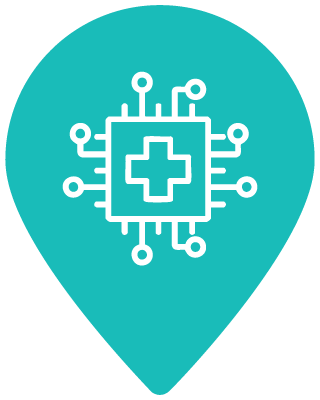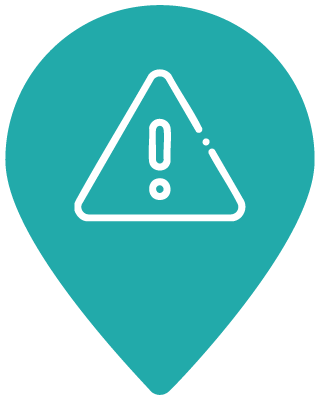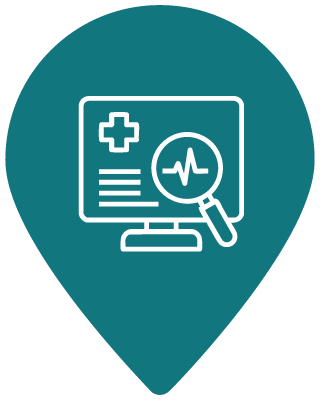
CRS Innovation Roadmap
Are you looking to develop a CRS de-risking product? This product development roadmap leads you through a strategic process to turn your vision into reality.
Key milestones help you build products that deliver increasing value for patients and healthcare providers. Use this roadmap to focus on what’s possible today, while laying the foundation for more effective risk prediction models and products in the near future.

Deploy DHTs available today to monitor the same or similar vital signs and symptoms currently observed in the hospital environment.
Early warning products assess the probability of developing CRS, providing clinical decision support in a more deliberate manner than CRS monitoring alone.
Harder-to-capture or more complex CRS risk predictors may be discovered, improving our ability to stratify patients into CRS risk categories and enabling appropriate clinical actions as early as possible.
Research into new immunotherapies would benefit from the availability of a robust CRS safety biomarker to enhance the safety profile of clinical trials, increase trial access, streamline regulatory decision-making, and ultimately improving outcomes.
A diagnostic goes one step further than risk prediction and may redefine the current CRS grading classes. Using a data-driven approach, it can support clinical decisions in a more autonomous manner, enabling less specialized healthcare personnel to manage patients effectively.
 Digital monitoring
Digital monitoring
- Goal: Deploy DHTs available today to monitor the same or similar vital signs and symptoms currently observed in the hospital environment.
- Impact: Shorten time-to-market by relying on existing DHTs and standard of care measures to immediately support healthcare providers and immunotherapies in the outpatient setting, reduce patient burden, and shorten hospitalization periods.
- Barriers to adoption: The technical challenges are largely resolved, however, work is needed to make clinical workflows compatible with a remote patient monitoring approach, including reimbursement and EHR integration challenges.
- Examples: TempTraq, Current Health RPM Platform, and the Apple Watch are used in clinical trials and care for remote monitoring of CRS and other immunotherapy-related events in outpatient settings.
 Early warning
Early warning
- Goal: Early warning products assess the probability of developing CRS, providing clinical decision support in a more deliberate manner than CRS monitoring alone.
- Impact: Early warning products provide advance notice about the development of CRS so that patients can be monitored safely from their own home. This improves patient safety, optimizes hospital resource utilization by relying more on the outpatient setting, and ultimately improves patients’ quality of life and access to treatment.
- Barriers to adoption: Early warning products need to reliably assess the probability of CRS without creating too many false positives. In addition to the early warning product itself, clinical change management is likely needed to determine if this approach can reduce the occurrence of high grade CRS and hospital readmissions.
 Prediction
Prediction
- Goal: Harder-to-predict or more complex CRS risk predictors may be discovered, improving our ability to stratify patients into CRS risk categories and enabling appropriate clinical actions as early as possible. Predictive algorithms should assess the CRS grade, probability of more severe CRS, and duration of the CRS event as impacted by the timing and type of clinical interventions.
- Impact: Predictive products combine the clinical benefits of monitoring and early warning products and augment them with sensor and context data that is not necessarily part of the current standard of care. This improves our ability to look further into the future and take appropriate preventive or corrective actions.
- Barriers to adoption: Prediction products must be built on a robust reference measure for analytical validation, clinically validated based on sufficiently robust data, and accompanied by a clear value proposition (clinical utility) for providers.
 Safety biomarker
Safety biomarker
- Goal: Research on new immunotherapies would benefit from the availability of robust CRS safety biomarkers to enhance the safety profile of clinical trials, increase trial access, streamline regulatory decision-making, and ultimately improve outcomes.
- Impact: Early safety biomarkers would rely on prior roadmap milestones and are likely to first be incorporated as an exploratory endpoint. With sufficient evidence, the biomarker could be optimized to support pivotal trials and regulatory decision-making, for example through a qualification pathway.
- Barriers to adoption: Reaching that level of maturity will involve long timelines, likely requiring large-scale collaborative efforts.
 Diagnostic
Diagnostic
- Goal: A diagnostic goes one step further than risk prediction and may redefine the current CRS grading classes. Using a data-driven approach, it can guide clinical decisions in a more autonomous manner, enabling less specialized healthcare personnel to manage patients effectively.
- Impact: Current CRS grading scales rely on the type and level of clinician intervention. As CRS de-risking products become more effective, a diagnostic product may redefine the current CRS classification with a more evidence-based approach. A diagnostic product would be able to handle clinical decision-making in an almost autonomous manner, thereby boosting patient quality of life, safety and treatment access, and further optimizing healthcare costs.
- Barriers to adoption: Very high clinical evidence and likely stringent regulatory review may be required depending on the level of claimed decision-making autonomy of the product.
Discover how others are using these resources

Nazila Shafagati | John’s Hopkins Medical Oncology

Cindy Varga | Atrium Health

Erik Koenig | Takeda

Leveraging DATAcc by DiMe’s ontology for data transfer specifications development for early detection of CRS in CAR-T and BiTE therapy patients

Melinda Chen & Erik Koenig | Takeda

Milos Todorovic | Director of Biomedical and Clinical Engineering Analog Devices, Inc.

Optimizing sepsis and CRS detection: A data-driven approach to improve patient outcomes

Lavi Kwiatkowsky | Founder & CEO, Canopy

Premal Kamdar | Director, Digital Health Product Management, Bristol Myers Squibb

Michael Pettinati | Senior Data Scientist, ActiGraph
Additional resources to support your success

Digital clinical measures

Practical guide
Bring your CRS de-risking product to market with expert strategies for development, safety, streamlined workflows, and adoption—all in this guide.